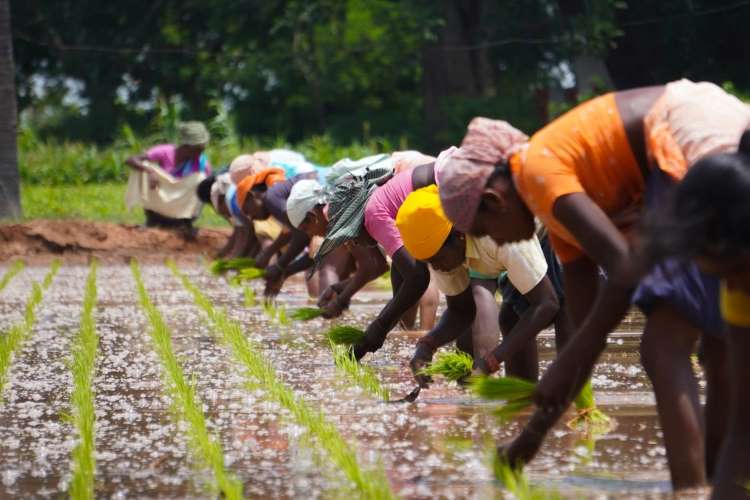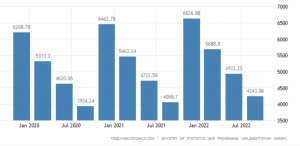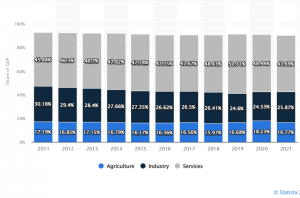
India’s agriculture and rural sector were bright spots in the Indian economy during the pandemic and post-pandemic periods. The sector has been an outlier during periods of distress, but the gains do not translate into higher incomes for farmers. The spillovers of Russia-Ukraine war got reflected in the rural economy, and the wages fell sharply. What goes on in the rural economy has its impact on sectors such as FMCG and automobiles with rural spending remaining sluggish.
With the Union budget round the corner, it is time for the government to shift focus to the sector which accounts for close to a fifth of India’s GDP. The nation must also extend some courtesy to the sector at times of distress as it provides employment to more than 40% of total employment. The government needs to spend more in the rural economy to help it absorb the excess workers in the system. According to economy watchers, increased spending is the only way to boost demand.
India GDP from agriculture

READ | Public health: India must step up funding, leverage technology to improve access
While the government raised its spending under the Mahatma Gandhi National Rural Employment Guarantee Scheme (MGNREGS) to create jobs for those who returned from cities during the pandemic crisis, rural India continued to scramble. High inflation was a nationwide problem this year which meant wage growth did not keep pace. Inflation breached the Reserve Bank of India’s medium-term target of 4% in October 2019. That the rural economy is under distress is evident from reports. A study by NielsenIQ suggests that the volume growth of FMCG goods in the September quarter declined in rural areas.
The question of farmers’ income
It is a national shame that despite agriculture being so important to the economy, the farmers’ incomes have remained dismally low and despite various political promises, the country has not been able to deliver justice to farmers. According to data compiled by the Reserve Bank of India (RBI), in Madhya Pradesh, male agricultural workers in rural areas got a daily wage of just Rs 217.8 while in Gujarat, it worked out to Rs 220.3 in the year ended March 2022. The national average stands at Rs 323.2 which is nothing to be write home about.
India GDP distribution

A rural farm worker is best placed in Kerala as the state pays the highest wage. In Kerala an average of Rs 18,170 for 25 days work in a month is given. Compared to this, a rural farm worker makes Rs 5,500 per month in Gujarat which may not be sufficient to meet the expenses of a family of four or five people. This is when inflation is at an elevated level and interest rates are on the rise.
Even while the cost of cultivation has been rising in the labour-intensive but low-returns sector, prices of key crops have not risen in tandem with cultivation costs. Coupled with other vagaries such as unpredictable weather conditions, rural India has only suffered with agriculture still remaining a major job provider. The cost of cultivation rose by 14% in the kharif season this year, led by a 70% increase in machine labour costs, suggests a report by Motilal Oswal Financial Services, but the returns were not heartening.
Even while the prices of key foodgrains went up by 5.8% year-on-year this kharif season, inflation was above 6% across for most parts of the year. Leaving alone the question of profitability, farmers scrambled to make ends meet.
Positive trends in rural and agriculture economy
One of the positive changes seen in the rural economy was a shift of manufacturing activity and employment from bigger cities to smaller towns and rural areas. A difference in urban-rural costing ratios was a major proponent to this shift. According to the latest survey industries, the rural segment is a significant contributor to the manufacturing sector’s output. The survey also found that 42% of factories are in rural areas with 62% of fixed capital in the rural side. With this, factories set up in the rural areas are contributing exactly half of the total sector in terms of output and value addition.
Another proponent to the rural economy has been the dairy sector. Prime Minister Narendra Modi recently said that women-led development in the country has also been on a rise owing to their increasing participation in the dairy sector.
Much needed reforms
It is not as if there is a dearth of government schemes to aid farmers but the question is of execution. Take for example the PM-KISAN scheme which extends Rs 6,000 per year as income-support for farmers. The problem with the scheme is that the transfers are made to landholding farmers while the more vulnerable landless labourers and casual workers remain out of access. However well intended the schemes may be, they become irrelevant when they fail to cover the poorest of the poor.
The agricultural sector is heavily dependent on weather conditions. With changing climatic conditions all over the world, it becomes even more pertinent to safeguard the sector from vagaries of weather. The government and policymakers must take steps in the direction and find alternate ways to support cultivation not just for the sake of farmers but to ensure that India does not fall prey to food shortages.
